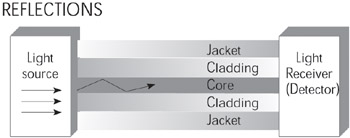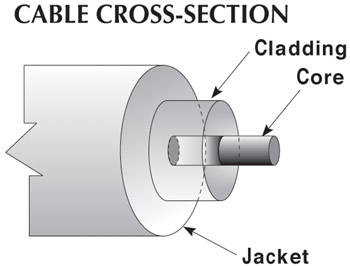Fiber Optics for Networks
| |
In networking applications, fiber- optic cable offers several advantages over copper wiring. For a given length of cable, fiber has far less signal attenuation than copper , which allows you to use longer cable runs.
A copper circuit can pick up unwanted electrical "noise" ( spurious signals unrelated to the desired source signal). This noise is electrically induced into the circuit by virtue of the cable running close to AC power wires, fluorescent lights, or other noise sources. A copper circuit can also pick up stray signals from adjacent data circuits. What's more, if the circuit is close enough to be picking up outside data signals, it's also likely to be inducing its own signals into the other circuits. This problem is known as "crosstalk."
A further disadvantage of copper data links is that they are susceptible to transient overvoltages (or impulses), which can momentarily reach hundreds or thousands of volts . Transient overvoltages can damage computers and networking equipment and, at the very least, they can be erroneously interpreted as data, leading to problems similar to those caused by electrical noise contamination.
Finally, the numerous copper-wire network links between computers can potentially cause electrical ground loops that interfere with signal reception .
With optical fiber networks, these types of problems can be avoided. Fiber-optic links use light as the medium for data signaling. An optically clear glass fiber functions as a light guide, carrying a light signal from source to destination. The fact that the fiber does not use or carry electrical signals makes it immune to induced electrical signals and impulses. And since glass is an electrical insulator, using fiber-optic links is the best way to avoid network ground loops. Even with these advantages, fiber optics is still a new technology to the LAN world, and it may seem foreign to many network managers. This Fiber Optics for Networks "tutorial," then, is aimed at enlightening you (if you'll pardon the pun) about this relatively new medium.
Bouncing Along
Figure 1 shows how light travels along a fiber-optic light guide. The light source could be almost any type of light, but for networking applications where very high-frequency signaling is desired, a specialized LED is typically used. At the other end of the light guide is some type of light receptoroften a photodiode.

Figure 1: Lan travels along a fiber-optic light guide (or cable) from a special LED light source to a photoreceptor. The cladding layer reflects back any stray light waves traveling along the core .
A fiber-optic cable consists of several layers (see Figure 2). The "core" is glass of extremely high optical claritya tiny filament typically 62.5 microns in diameter. The core is surrounded by another layer of glass, known as the cladding, which typically has an outer diameter of 125 microns. The entire fiber (core and cladding) is usually encased in a plastic jacket, for mechanical protection. The material used for the jacket will depend on building codes and other mechanical requirements of a particular network installation.

Figure 2: A fiber-optic cable consists of several layersan inner glass core of extremely high optical clarity, a wider glass cladding layer, and an encasing jacket.
Only the core and cladding are involved in the light transmission. Cables are typically specified according to the diameters (in microns) of these two layers. Thus, the cable just described would be listed as 62.5/125 micron optical fiber.
Physicists classify light-passing media according to their index of refraction, a measurement that correlates with the speed at which light travels through it. The kinds of glass used for the fiber's core and cladding have slightly different optical indices of refraction. As a result, light rays are reflected at the boundary between the two layers. As shown in Figure 1, light rays traveling along the core will be reflected back inside, should they stray toward the cladding. Thus light can't get out of the core, and that makes the core an excellent light guide.
A Common Thread
One type of fiber-optic cable can serve virtually all local area networking needs, says N. D'Arcy Roche, president and CEO of Raylan (Palo Alto, CA). This is the 62.5/125 micron multimode fiber that's specified for Fiber Distributed Data Interface (FDDI). "It is a dual-fiber cable that can be either a two-fiber duplex cable (like an electrical lamp cord) or two fibers in a round jacket," Roche says. "This cable can accommodate 10Mbit/sec Ethernet, up through OC-12 (622Mbit/sec) speeds. This eliminates the question of what fiber to choose for a given installation."
Roche says that this fiber can serve for either of two commonly used transmission wavelengths 1,300nm and 850nm. FDDI, as currently specified by the IEEE, uses the 1,300nm transmission window, but Roche says that several vendors (Raylan included) have introduced 850nm options for FDDI. The LED light sources and photodiode receivers for 1,300nm operation are expensive, while 850nm devices are substantially lower in cost.
The 62.5/125 micron multimode fiber has a bandwidth of 160MHz over a length of 1km, with 3.75dB of signal attenuation (light reduction) when operating in the 850nm band . At 1,300nm, the same fiber has a bandwidth of 500MHz, over a distance of 1km, with 1.5dB of attenuation. Over shorter distances, bandwidth increases and attenuation decreases, but you can see that fiber cable can comfortably accommodate cable lengths approximately an order of magnitude greater than UTP copper wiringwith greater bandwidth and far less attenuation.
Going The Distance
Telephone companies and other long-distance carriers typically use single-mode optical cable, which has a much smaller corein the range of 8 microns. It offers a wider bandwidth than multimode fiber, and substantially lower attenuation per kilometer. These factors make it the ultimate medium for city-to-city communications, as signal repeaters can be spaced many kilometers apart, reducing costs and maintenance requirements proportionately. But taking advantage of single-mode fiber, typically, also means using rather exotic (and expensive) laser light sources and photo receivers. For in-building networking (as well as campus cable runs of less than 1km), multimode fiber is the cable of choice.
Thomas-Conrad (Austin, TX) is another major player in optical fiber-based networking, with its Thomas-Conrad Networking System (TCNS), a 100Mbit/sec network that competes with FDDI. (Unlike FDDI, TCNS is proprietary.)
Peter Rauch, director of product marketing for TCNS, says that Thomas-Conrad specifies multimode cable with core diameters of 50 microns to 140 microns, but that 62.5-micron cable is the most frequently used. TCNS uses the straight tip (ST) connector developed by AT&T. This bayonet-type connector fastens with a quarter- turn and looks similar to the BNC connector commonly used with thin Ethernet cabling.
Light Standards
It's common to associate fiber-optic cabling with high data rate applications such as FDDI and TCNS, but optical fiber can also be used for Ethernet and Token Ring. The Fiber Optic Inter-Repeater Link (FOIRL) standard is used to connect Ethernet hubs. FOIRL doesn't boost the data rate for Ethernetit's still 10Mbits/secbut it does allow you to connect hubs with cable runs of up to 1km. More recently, the IEEE has come out with a 10BaseFL specification that's comparable to FOIRL, but allows 2km cable runs.
The IEEE's 802.5j standard addresses Token Ring over fiber-optic cable, but this specification only covers " drops " (hub-to-end-node). There is no standard covering the use of fiber for the connections between hubs (using the Ring Out and Ring In ports). While various vendors offer solutions for fiber connections between hubs, these are proprietary, so you can't count on interoperability among them.
The fact that all commonly used networking technologies can use 62.5/125 micron multimode fiber means you can install fiber now, run Ethernet or Token Ring initially, then move up to higher speeds100Mbit/sec FDDI or TCNS, or 155Mbit/sec Asynchronous Transfer Mode (ATM)in the future.
You can't count on all systems using the same termination at the ends of the cables, however. The ST connector is perhaps the most commonly used. If you should move from one type of network to another, you may have to change connectors accordingly , but both Roche and Rauch say that this is seldom a problem. For example, if you have in-the-wall cabling that uses ST connectors, and network adapters that use a different connector, you can use patch cords with the appropriate connectors at each end to make the transition.
Who are the major suppliers of fiber-optic cable and connectors, and how do you choose the specific type you need? Rauch recommends that you seek the advice of your local cable installation contractor, who will know the local building codes and which cable is best for specific applications.
Fiber-optic cabling is gaining popularity as its cost comes closer to parity with copper. Its transmission properties are unquestionably desirable, particularly for high-speed networks or in cases where long distances must be spanned . If you're looking for more illumination on the subject, consult vendors of fiber-optic systems for background materials. I'd also recommend The Technician's Guide to Fiber Optics by Donald J. Sterling (Albany, NY: Delmar Publishers, 1987 and 1993; ISBN 0827358350). The first edition lacks the latest informationon Ethernet 10BaseFL, for examplebut it offers an excellent discourse on the physics of optical cabling, light sources, and detectors. I haven't had the opportunity to review the second edition, but it should be considerably more up-to-date on the latest standards.
This tutorial, number 75, written by Alan Frank, was originally published in the November 1994 issue of LAN Magazine/Network Magazine.
| |
EAN: 2147483647
Pages: 193
- Chapter I e-Search: A Conceptual Framework of Online Consumer Behavior
- Chapter II Information Search on the Internet: A Causal Model
- Chapter IV How Consumers Think About Interactive Aspects of Web Advertising
- Chapter X Converting Browsers to Buyers: Key Considerations in Designing Business-to-Consumer Web Sites
- Chapter XVI Turning Web Surfers into Loyal Customers: Cognitive Lock-In Through Interface Design and Web Site Usability